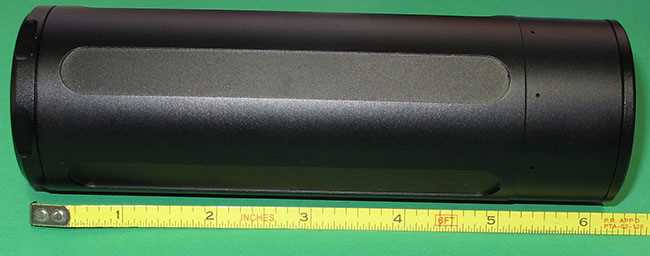
The Ronin airgun silencer from DonnyFL.
This report covers:
- Why?
- Remove the rear end cap
- Remove the insides
- Felt blanket
- Assembly
- Fix the silencer?
- Summary
Today we’re going to look inside the Ronin airgun silencer from DonnyFL. This is a report I think you folks want to see.
Why?
After all the comments about the silencer in Part 3 of the Benjamin Gunnar report — the accuracy test — I thought you might like to look inside. This one is easy to disassemble, unlike my firearm silencer, so I thought, why not?
Reader shootski said the following, “The RONIN and other DonnyFL silencers are easily disassembled, “Take apart in less than 10 seconds by unscrewing the rear end cap and pushing back the mono-core. No hex key or torch needed when you want to perform maintenance inside the unit.
I don’t own a RONIN but wouldn’t describe the internals on my DonnyFL silencers as baffles (like on a Marauder or most firearm silencers) on any of mine.”
Okay, I knew it was easy to take this one apart so I did. Let’s see what’s inside.
Remove the rear end cap
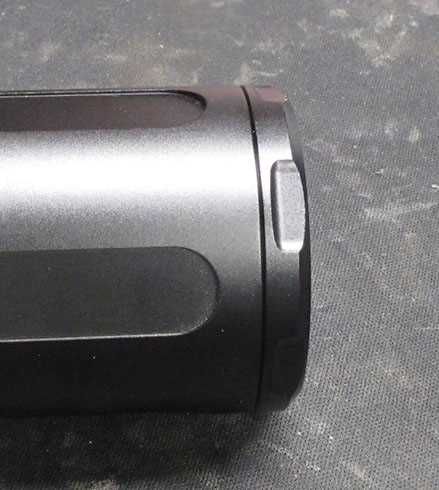
There are flats on the end cap of the Ronin that allow the use of a large spanner.
I used a pair of Channel Locks opened as wide as they would go with the jaws cushioned by a shop towel. Once I turned the end cap it came loose. It was just too tight for removing by hand.
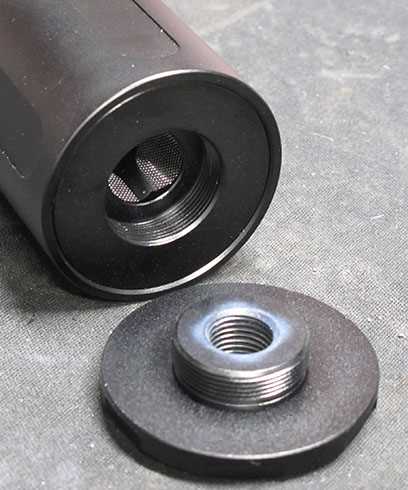
The end cap comes off. See the lighter area around the inside of the cap? This is where the term lead dust collector comes from.
Remove the insides
Once the end cap is off all you have to do is push in on the other end of the silencer and the whole guts come out.
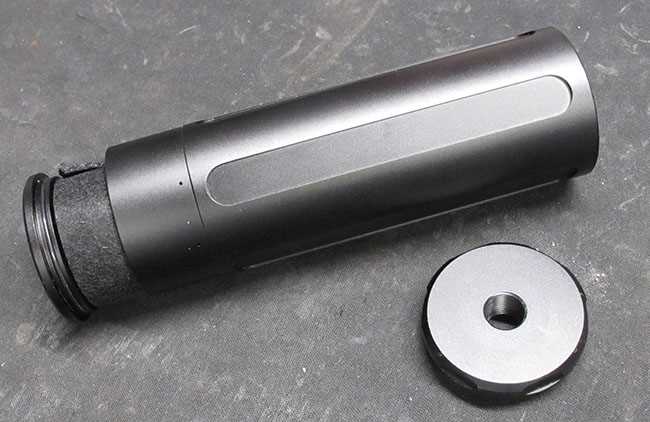
Just push on the other end of the silencer, the end the pellet comes out, and the inside pushes straight back and out the rear where the end cap was.
Felt blanket
The guts of the silencer are wrapped with a felt blanket that dampens the sound as it tries to escape. This is one way to do it, but my firearm silencer doesn’t have this blanket. Probably the hot gasses would make short work of it. But an airgun doesn’t have hot gasses, so it works.
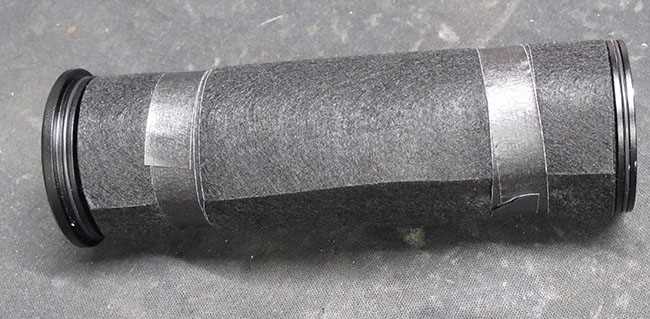
The guts of the silencer are wrapped with a felt blanket.
The felt blanket is held on by tape. Once it’s removed, it reveals a wire screen with thin mesh that’s wrapped around the baffles.
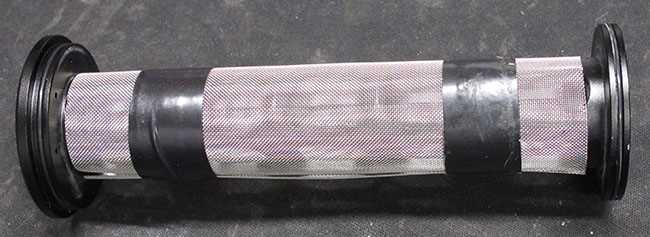
Under the felt blanket is a wire screen around the baffles. It’s held on by tape.
Baffles
Shootski says he wouldn’t describe what’s inside the silencer as baffles. Well, I don’t know what else to call them. Yes, they are not separate pieces like we find in a Marauder shroud, but no firearm silencer I have ever seen had separate pieces. I’m not saying they don’t exist — just that I have never seen them.
Some firearm silencers that absolutely have to be silent are filled with petroleum jelly and have polyurethane disks called wipes that the first bullet shoots through and subsequent bullets push aside as they pass through. The petroleum jelly is good for only a couple shots before it has to be refilled and the wipes wear out quickly (30-40 shots), as well. These are the super-silent silencers called the “Hush Puppy” that are like what Hollywood shows us in action thrillers.
Okay, those Hush Puppy silencers are for “wet work” (assinations, etc.) that absolutely has to be quiet. Now let’s get back to the real world and the Ronin.
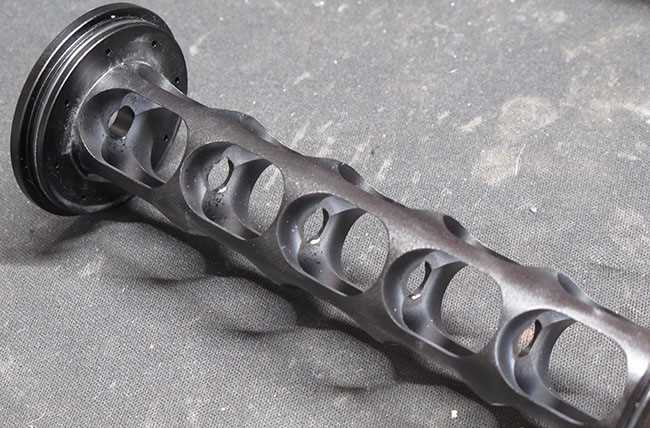
Ronin baffles.
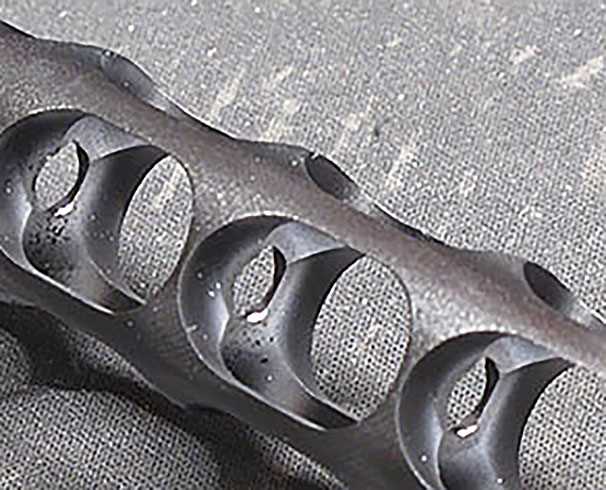
In this image you can see where the .22-caliber pellets nicked three of the baffles on their way out of the silencer. I have not used this silencer since the Gunnar accuracy test, so those nicks are what caused the rifle’s inaccuracy.
Assembly
After taking all the pictures I assembled the silencer in reverse of the order in which it was disassembled. It went quick and easy and the entire job including photos only took 30 minutes.
I had to twist the internals to get them back into the can neatly. But it was easy.
Fix the silencer?
This is where the guys who like to tinker step in and enlarge the holes through the baffles. Other guys say just keep shooting through it and eventually the pellets will clear their own path. I tend to be in the latter camp. I have several air rifles on which this silencer works well, and as I told you, the Gunnar doesn’t really need to be silenced. So I’m not cutting up the baffles in mine.
Summary
The DonnyFL silencer works well and just as it should. You have now seen the insides and possibly understand how it works a little better.


I’m guessing the Gunnar gets a bit sloppy with the weight hanging off the end. Is the barrel floated inside the shroud? Then the shroud just is weighted down? Seems like it.
B.B.
What size caliber is that for? Or is it a “one size fits all” scenario?
I find that the size and location of the exit hole is key to accuracy. Maybe that is why your accuracy went in the toilet when using it?
-Y
Yogi,
The DonnyFL are caliber range specific within the named units as well as volume based on each named line of silencers. The airgun silencers work almost 100% on having enough volume to expand HPA into LPA since there is no hot gas to cool.
From what i was taught about silencers by Uncle Sam as soon as a spinning projectile clips the very first fixed surface it starts to wobble off axis and never recovers.
shootski
WRONG!
https://donnyfl.com/collections/ldc/products/1-22-x-5-inches-tanto
All on the products come with an endcap that “covers” 2 calibers. Mine is a .177-.22 Tatsu. I put it on my FT gun and accuracy went down the drain. I put a Hugget on the end and accuracy IMPROVED!
Why do you think B.B. had to remove the Ronnin to finish his report?
Try loading a .177 pellet in a .22 cal gun and see how well that works…lol.
-Y
Yogi,
“WRONG!” is strong words when a few of the end caps are listed as one (1) caliber specific e.g., the metric threaded .357 cap for one of the FX air rifles; of ourse some folks report buying oversized for caliber to avoid clipping altogether and living with a slightly reduced amount of sound reduction.
As far as your experience with improved accuracy with a silencer brand swap there are so many factors involved in why that occured….
Be Well,
shootski
For this one it’s clipping before the end cap, so it doesn’t matter if it’s. 177 or a .30 end cap.
Well the good news is that even though the DonnyTasu that I bought do not work well on my .177 FT guns. I can now try it on my .22 hunting guns, lol. The guys at the range love them on their .25 PCP’s but for my 12 fpe springers, not so much…
-Y
Yogi,
My silencer is a .22 caliber. I chose that because .22 is my favorite caliber and also because it will work for .177 (and .20).
BB
Yes, just perhaps not very well.
I have 6 or 7 LDC’s. The better ones also act as an air stripper and improve accuracy. Sometimes dramatically!
-Y
B.B.,
If you look at the photograph captioned Ronin Baffles you will see on the End Cap hole what looks like a small strike.
Perhaps of interest to your readers who watch the video, running an airgun silencer WET will do little to nothing for sound attenuation since their is no hot gas to cool.
You can run a firearm silencer WET with water, KY, Line Puller Jel, Slippery Stuff and other water based agents much cleaner than petroleum based stuff that burns, smokes, and stinks giving away your location.
I still think your shroud was the problem.
shootski
shootski,
I didn’t notice that before you mentioned it, but I do see it now.
I think you are correct about the shroud. It lends itself to tolerance creep.
BB
Shootski
What do you mean by you still think the shroud was the problem.
If the Gunnar shroud is internaly like the Marauder shroud I don’t think that caused the problem.
Although since the Gunnar does use a different muzzle end cap I believe that is the problem. I think the shroud threads on the end where it screws into the Gunnar’s shroud is not concentric to the threads on the other side of the shroud end cap where the silencer screws onto the Gunnar’s end cap.
That is causing the silencer to be off center to the Gunnar’s barrel.
GF1 and BB
If you are right does that mean that BB’s silencer threads are off center or is it the threads on the Gunnar? Just trying to understand how much shooting it would require to overcome inaccuracy caused by pellets hitting the silencer’s internals. Maybe no amount of shooting would fix it.
Deck
Deck
I would say the problem is with the threads on the Gunnar’s shroud end cap on the side where the silencer screws on.
If it was the silencer threads then it would have problems I would think on other gun’s. But BB said his silencer works fine on other gun’s. I say the clipping in the silencer is coming from the Gunnar.
Gunfun1,
What I can say with some level of confidence is that I doubt it is the silencers direct fault. Something from the shroud threads to the shroud itself is likely at fault. Could be shroud droop, shroud bent, or misalignment of shroud threads and in that order based on past experience.
Looks like i suspect something is wrong with the shroud for mounting the Ronin ;^)
Easy way to find out is remove and replace the shroud if you really need the can! SOUNDS like B.B. doesn’t need the can on this Gunnar; for an absolute fact his garage door jamb doesn’t need it!!!!
shootski
PS: just saw your post to Deck…totally agree.
Shootski
Yep.
BB,
I have seen a firearm silencer with individual stamped metal baffles. It was meant strictly for .22.
Thanks for showing the Ronins’ guts BB!
…Curiosity satisfied 🙂
H
This was a very interesting blog. I learned a lot about silencers – never thought they could be this quiet. Just for giggles, does anyone, including you, BB, have a db level for the wet type silencer with the wipes installed?
Fred formerly of the Demokratik Peeples Republik of NJ now happily in GA
The monocore does have an interesting witness mark under the last pellet hit, its on the face of the inside of the exit endcap, looks like dirty air escaping there. Also the first chambers are not marked by a pellet hit. Sometimes a factory fit doesn’t even work. If the Gunnars shroud is torqued to the shroud mount, and it is not concentric afterwords, dont worry, the front shroud mount/blast diffuser will force it into alignment. Just one more thing to check . For close work, I like the look of the British
commando knife, the Sykes/Fairbanks blade I think it is called? For a pistol, I find a pillow with open cell foam works well, not as many alignment issues. Thanks for the look inside, nice pics!
Rob
If you watch a scope cam or slow-motion video of an air rifle during discharge, you can see a wave of vibration go through the gun/barrel. I can imagine that the harmonic could result in a pellet clipping in the LDC, just due to that. A larger bore could eliminate that, as could a different LDC, just due to the change in/new harmonics of the new “system” being set up.
Below is a link to a DonnyFL video, “DonnyFL: Choosing the right MODERATOR for your AIRGUNS”.
My take away is: To avoid clipping, use the next larger caliber size if the moderator is NOT threaded onto the barrel. For shroud mounting a moderator on a .22, use a .22/.25 DonnyFL. – Don
https://m.youtube.com/watch?v=XlNlBZRVvxg
Also In the video, their current version is now laser labeled and has more clearance than the previous version. The previous version are not laser labeled and were sold for each caliber not a range of calibers. The internal structures are sized differently for caliber, not just the end caps. If you are having a problem contact them about servicing the moderator. – Don [ not related 🙂 ]
I have an 8″x 1.5″ Hill moderator, it’s on the heavy side, but rigid. It works with hair curlers and bigger holes. You need to invent yer own fill system. A carbon shell would be lighter. He makes cool stuff for the Marauder too.
R